4 Staunch Reasons to Adopt Headless CMS for Online Commerce
For some, legacy technology such as monolith or SaaS ecommerce platforms and traditional CMS turned out to be bottlenecks to scaling. It follows that alternative approaches emerged such as MACH — Microservices, API, Cloud, and Headless architecture.
In this post, we would like to focus on the “H” — Headless CMS and Headless commerce in particular. You will learn what is a headless content management system (CMS), how it differs from a traditional CRM, and what benefits headless adoption leads to.
What is a Headless CMS?
A headless content management system (CMS) is a web app architecture pattern, where the frontend content presentation layer is decoupled from the backend applications and databases.
Unlike a traditional CMS, dictating content layout, structure, and formats, a headless CMS chops off a prescribed presentation layer. Because of this, you can choose to leverage any type of frontend technology and convert your content for omnichannel distribution across various mediums — be it an in-store tablet, mobile app, in-car dashboard, or unattended retail solution. Still, headless CMS solutions remain connected to the backend via an API, which pulls the content from the database.
Advantages of Headless CMS:
- Flexible front-end technology selection
- Extendable and easier to integrate with other applications
- Consistent, yet unique, customer experience across devices
- Higher information security
- Unconstrained scalability
- Prevents vendor lock-in
- Conducive to omnichannel retail operations
- Faster time-to-market for digital offerings
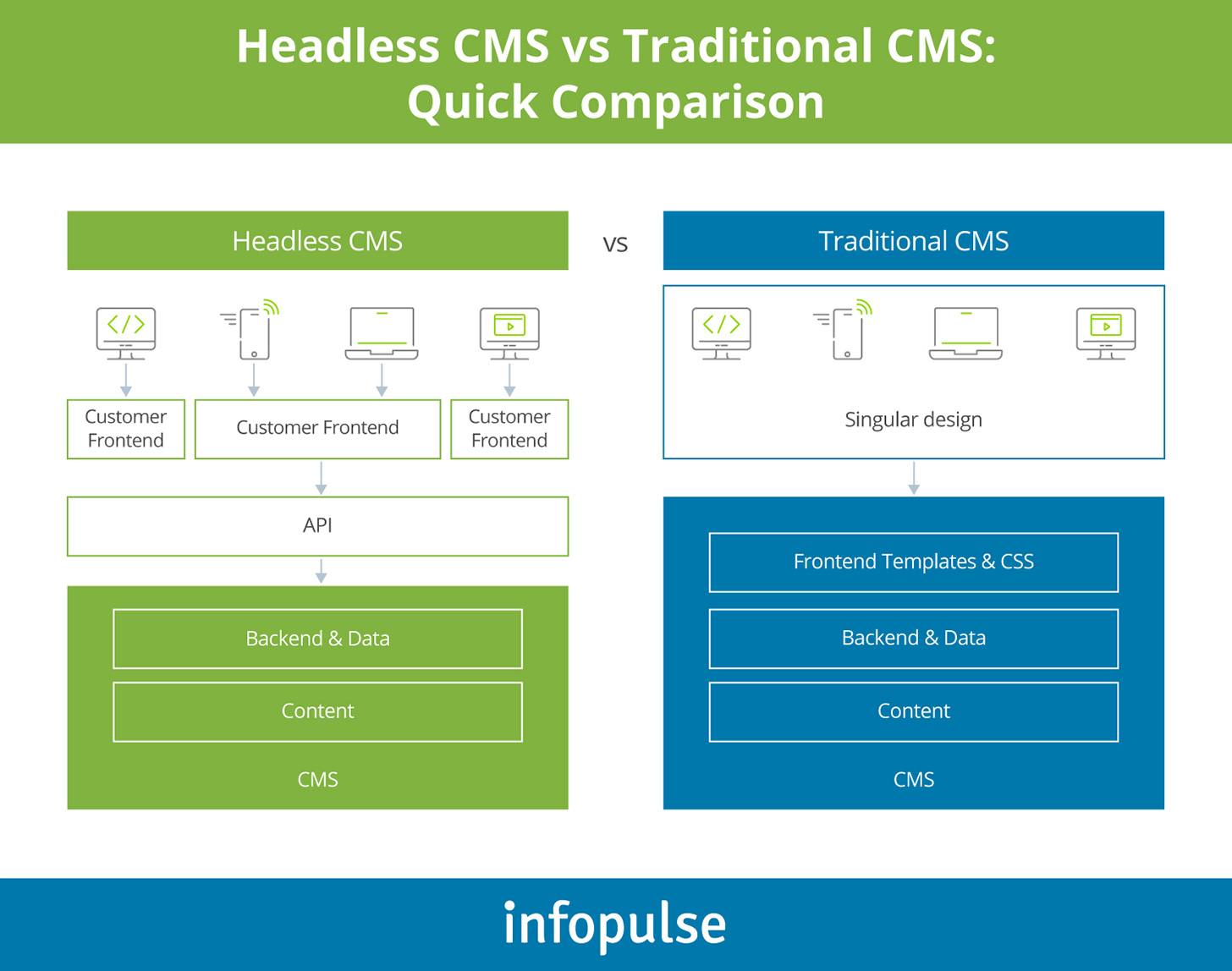
Traditional CMS systems have four connected components:
- Database for storing content
- Admin panel for content management
- Front-end visual layer for presenting stored content
- Page rendering engine, combining the above
All of these elements dictate how different content elements (text, video, images, etc.) will be presented to the user. In many cases, distributing a product catalog for your ecommerce store to another channel, for example, a self-service kiosk would require creating a separate connector and converter for ensuring proper interactions.
One of the biggest headless CMS benefits is that it removes the above constraints since such solutions come with no defined visual presentation layer. Instead, you have:
- A content database
- Content management panel
- API for connecting to the backend
What you should do next is to select the optimal tools and technologies to power your content operations. For example, transitioning to headless CMS architecture has enabled Eurostar to publish personalized content across 8 locales and 8 market segments, while also reducing CMS development tasks timeline from 2-3 weeks to 2-3 days.
Types of Headless CMS
The ability to deploy your CMS anywhere is a major part of the headless appeal:
- On-premises: Headless CMS solutions can be installed and developed on a local server or in a hybrid environment with a public cloud.
- Example: open-source dotCMS can be hosted on-premises or in the cloud.
- PaaS: Platform as a service (PaaS) solutions provide you with the baseline infrastructure for running your content operations and the tools to develop an experience of your choice.
- Examples: Optimizely Digital Experience Platform (former Episerver) or Sanity.io.
- SaaS: Headless SaaS CMS products, also referred to as Content as a Service (CaaS), provide an out-of-the-box toolkit for cross-channel content management. Such CMS solutions compensate lower customization opportunities with an attractive UI, WYSIWYG interface, and a host of value-added tools.
- Examples: Prismic, Contentful.
4 Main Reasons to Adopt Headless CMS
There has been a clear rise in the use of headless content management systems over the past years. As Umbraco report states, 51% of web development companies have recorded a higher demand for headless projects from their customers last year.
Specifically, businesses prioritize the following headless CMS use cases:
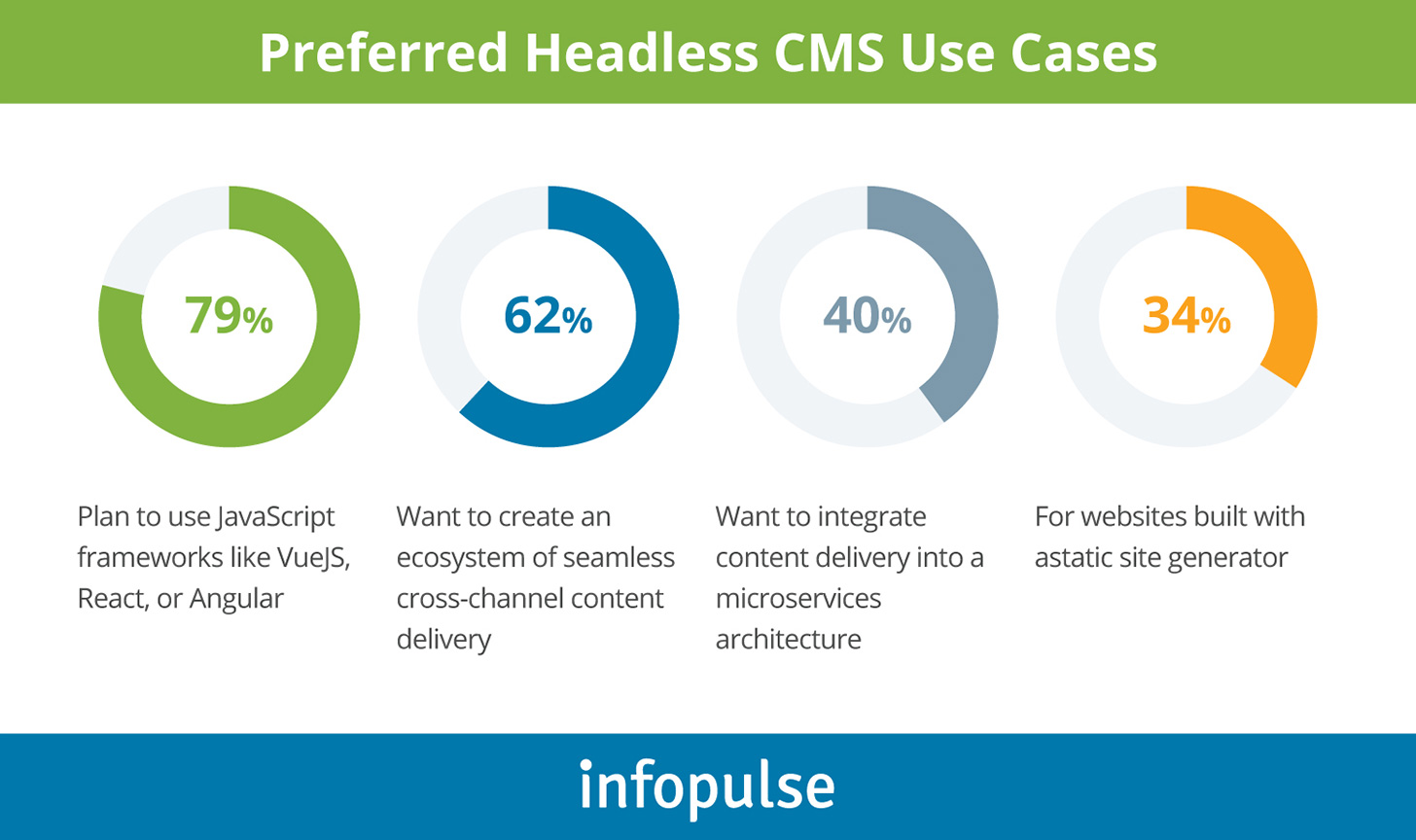
The above are just several technical reasons when headless CMS usage makes sense. Even more benefits follow from operational and business perspectives.
1. Improved Integration with Other Applications and Services
Larger retailers often have a growing technical estate of (often fragmented) business systems, ranging from point of sale (POS) solutions to multiple regional merchandising and marketing applications. Ensuring content integration and data standardization between them is often a laborious, manually-performed task.
By removing programming language constraints, your team can set up the necessary integrations between different systems and automate repetitive action. For example, you can set up APIs for sending and retrieving content, implement data versioning, and standardization for different content types across a portfolio of connected applications, services, and websites. Respectively, content managers will gain the ability to instantly push content globally across an array of channels without worrying about localization or formatting issues.
Arguably, this is one of the biggest benefits of headless CMS over traditional CMS:
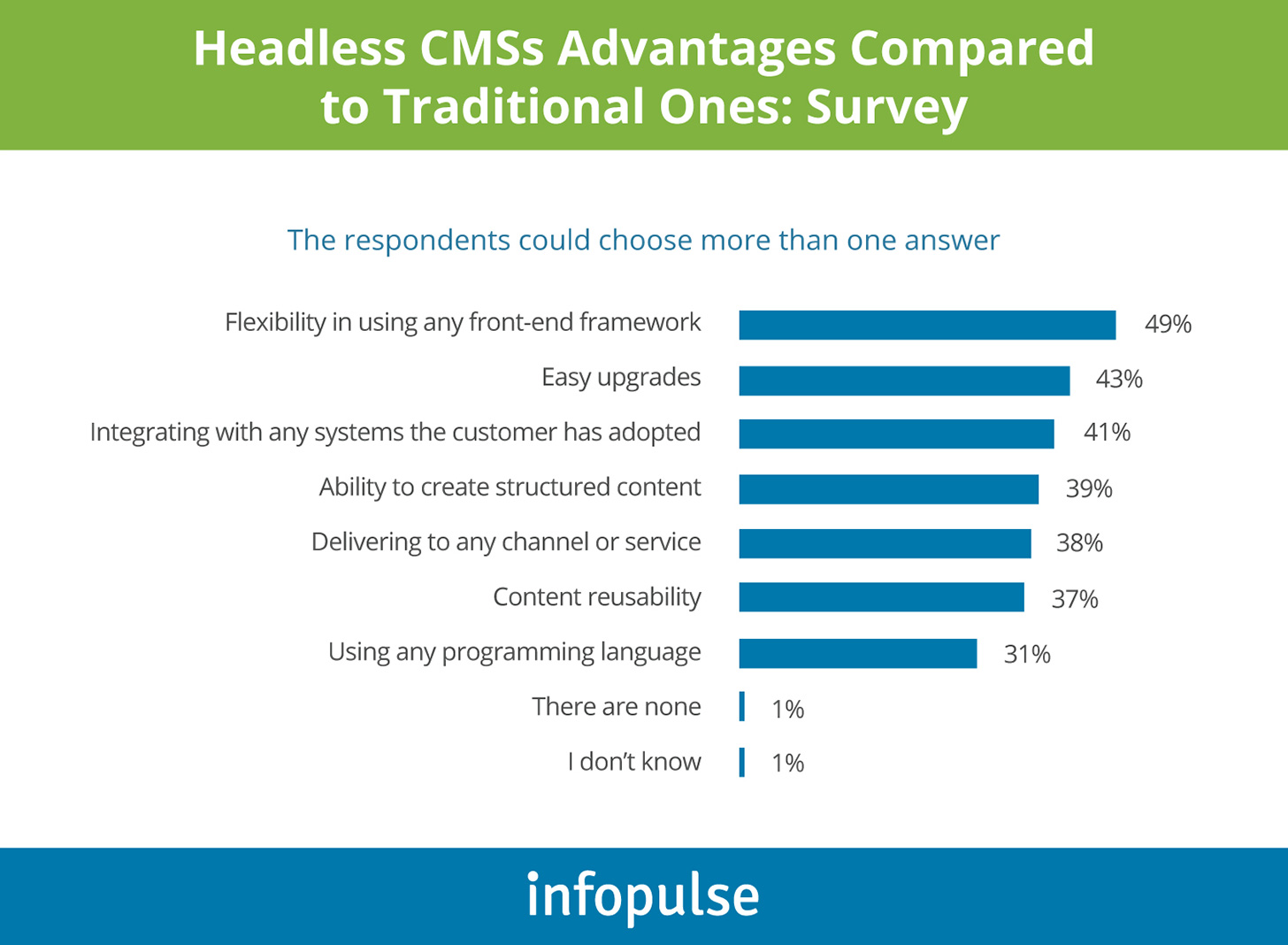
On the other hand, your pivot to headless CMS may leave the marketers wondering “Where did all the standard tools go?” as Forrester analysts caution. So in your pursuit of flexibility and decoupling, do not forget to ensure that all practice leaders have access to a collaborative content hub and content management capabilities they can use without developers’ help. Plus, integrations with other ecommerce business systems such as CRM, shipping applications, customer service systems, and martech solutions among others.
2. Greater Degree of Scalability
Since there are no underlying content presentation constraints, headless ecommerce setups can be scaled effectively across several verticals such as:
- Localized market presence (languages, currencies, marketing, and merchandising)
- Customer touchpoints (marketing and sales channels — apps, kiosks, embedded commerce solutions)
- IT infrastructure — cloud-first deployments, hybrid setups, edge deployments, etc.
Essentially, you can create a centralized content hub, connected to a data lake or data warehouse, interlinked with other business systems via APIs.
For instance, The Student Hotel recently migrated to Optimizely Content Cloud to power its global content engine. Post-adoption, the team switched to a headless single-page application, built on React, for serving different content types on an unlimited number of front-end channels — localized websites, apps, voice interfaces, lobby screens, connected TVs, and more. Now content delivery happens in top quality, at fast speed, and with a high degree of personalization.
Overall, the headless architecture allows your teams to explore new marketing channels and content formats without waiting on for the developers to come and help with new content template development. Also, by providing your teams with low and no-code development tools you can test and iterate small solutions to assess the ROI of a larger deployment.
3. Transition to Microservices Architecture
Microservices architecture has strong merit for modern applications as it promotes scalability, isolates performance issues, reinforces productivity, and fosters better software delivery cadence.
Similar to headless, microservices also allow you to use different programming languages for backend development (unlike monolith apps) and turn specific system functions into standalone services, managed as an independent product. Respectively, you can select to run a portfolio of best-in-class front-end and back-end tools to power your online selling operations.
From a technical standpoint, you have a selection of headless and microservices architecture patterns to consider, based on whether you plan to modernize a legacy platform or enhance an existing cloud-based system.
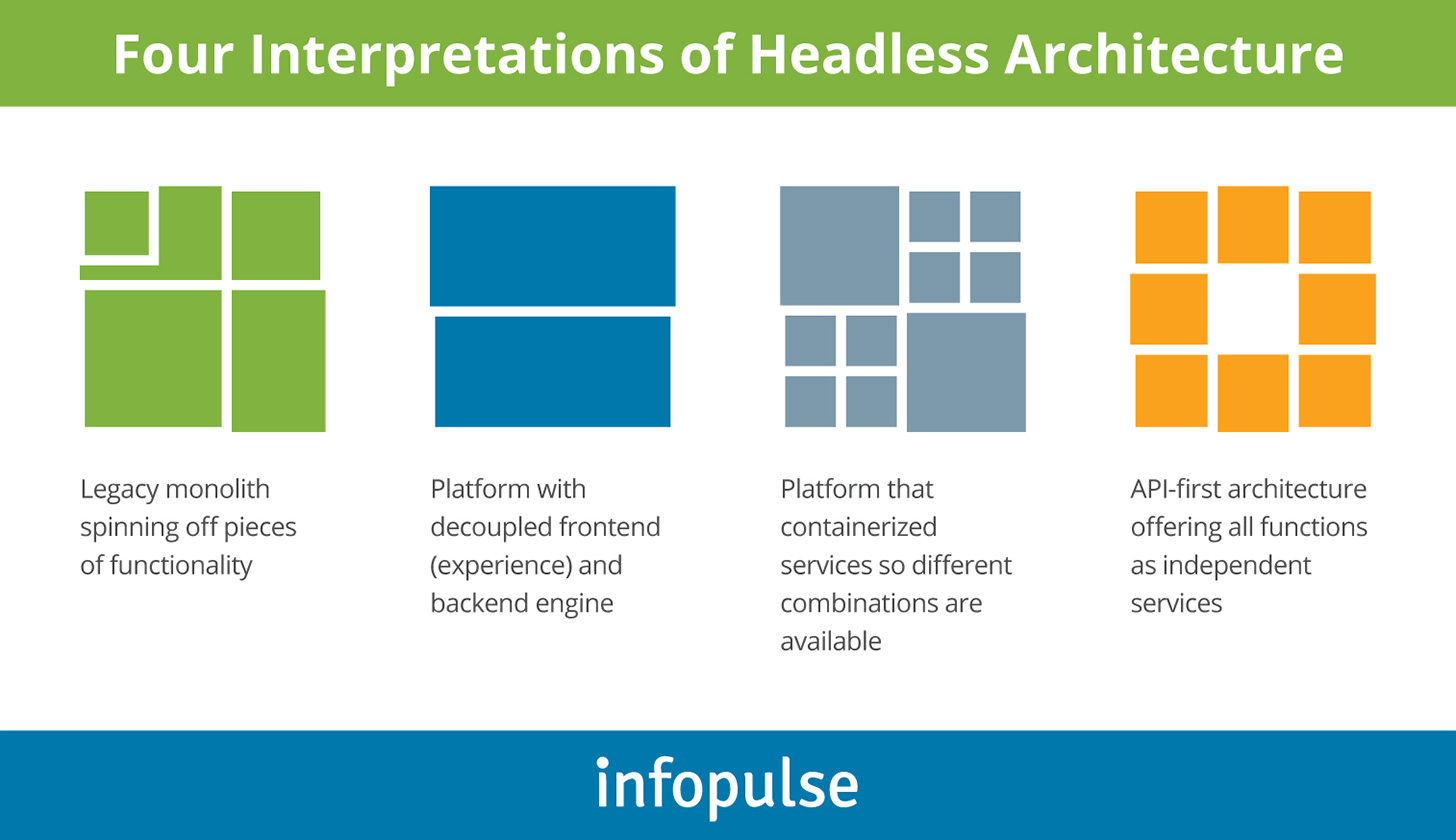
4. Double-Down on Omnichannel Presence
The most successful omnichannel strategies are focused on creating value for the consumers. As retail activities shift from offline to online, many consumers opt not to return to the physical stores or visit them as frequently as they did. This means businesses need to speed up and scale their ability to engage and serve customers across different touchpoints.
A headless approach acts as a core enabler for the above as the best headless CMS allows you to:
- Ensure a coherent, consistent, and relevant experience across all channels and touchpoints.
- Leverage unique channel capabilities and novel technologies (AR, chatbots, AI-based recommendation systems) to personalize the customer experience.
- Roll out new experiences faster, thanks to flexible deployment options.
Take it from Best Buy, a US retailer, practicing the headless approach. During the early days of the pandemic, the company managed to roll out a contactless curbside pickup service in 48 hours and supporting technical, marketing, and customer service infrastructure for operating it. During that period the company sales increased by over 250% and about 50% of orders were fulfilled via the curbside pickup.
Faster and more seamless service levels ultimately lead to higher customer experience (CX) — a strong brand differentiator and loyalty booster for brands. However, getting the CX right across multiple channels is a tough undertaking. Gartner reports that unless target action is taken now, by 2022 as much as 50% of large organizations will fail in unifying customer engagement channels, resulting in siloed customer experience that lacks context.
To prevent the above scenario always think about how a headless approach fits with the rest of your operations. Do you have timely and sufficient access to data to enable truly personalized content across different distribution channels? If not, think where self-service BI or big data analytics tools can be applied to help contextualize the available data.
Further, consider how customers interact with different channels as they embark on specific journeys with your company. Headless CMS gives you the ability to enhance and personalize those paths, but you first need to map them. Likewise, this will often require better customer analytics and visibility into the common touchpoints and interaction types per channel.
To Conclude
Headless CMS promises to turn companies into “virtual hydras” — creatures with multiple heads, each looking in a different direction. Each head can have unique features (presentation layer) and the ability to utilize different tongues (localization and content personalization). However, you will retain a single brain, responsible for operational guidance.
As such, headless architecture makes your operations more agile and future-proof as you can always “chop” the underperforming head and grow a better one instead. Yet this agility comes at a cost of careful initial architecture planning and continuous system maintenance.
Contact Infopulse to learn more about different headless CMS implementation scenarios and learn about Optimizely headless CMS capabilities.


![Pros and Cons of CEA [thumbnail]](/uploads/media/thumbnail-280x222-industrial-scale-of-controlled-agriEnvironment.webp)
![BPO in Telecom and BFSI [Thumbnail]](/uploads/media/thumbnail-280x222-ways-business-process-outsourcing-bpo-can-help-telecom-bfsi-and-other-industries-advance.webp)


![Digital Twins and AI in Manufacturing [Thumbnail]](/uploads/media/thumbnail-280x222-digital-twins-and-ai-in-manufacturing-benefits-and-opportunities.webp)
![Mobile Banking Trends [Thumbnail]](/uploads/media/thumbnail-280x222-mind-your-app-why-reinventing-mobile-banking-really-matters.webp)
![ServiceNow for Manufacturing [Thumbnail]](/uploads/media/thumbnail-280x222-seven-ways-servicenow-drives-digital-transformation-in-manufacturing.webp)
![AI and RPA Integration for Banking [Thumbnail]](/uploads/media/thumbnail-280x222-ai-and-rpa-integration-for-banking-possibilities-of-intelligent-automation.webp)
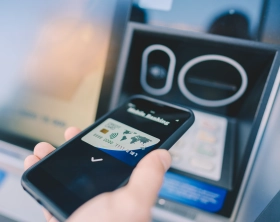
![Manufacturing Trends 2024 [Thumbnail]](/uploads/media/thumbnail-280x222-manufacturing-trends-that-will-shake-the-world-in-2024.webp)